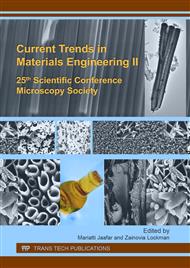p.182
p.186
p.190
p.194
p.198
p.202
p.206
p.211
p.215
Utilization of Metroxylan sagu Pith Waste as Biodegradable Filler for Natural Rubber (NR) Latex Films
Abstract:
Utilization of agricultural waste toward sustainability has increase a value-added product from a natural resources nowadays. Metroxylan sagu pith waste (MSPW) is a residue from starch extraction process. This research aim to investigate the potential of MSPW as a biodegradable fillers to replace sago starch in Natural Rubber (NR) latex films. The MSPW flour is characterized and compared with sago starch. Results shown MSPW has almost similar properties with sago starch with high content of starch (60%) and moisture (80%). Spectra of MSPW and Sago Starch (SS) are very closed to one another due to the similarity of functional groups. SS has granular shape while MSPW has irregular shape under SEM analysis. The addition of MSPW shown slightly lower tensile properties and tear strength as compared to SS but still within the acceptable value. Thus, MSPW has high potiential to replace SS as biodegradable fillers in NR latex films.
Info:
Periodical:
Pages:
198-201
Citation:
Online since:
September 2017
Authors:
Price:
Сopyright:
© 2017 Trans Tech Publications Ltd. All Rights Reserved
Share:
Citation:


